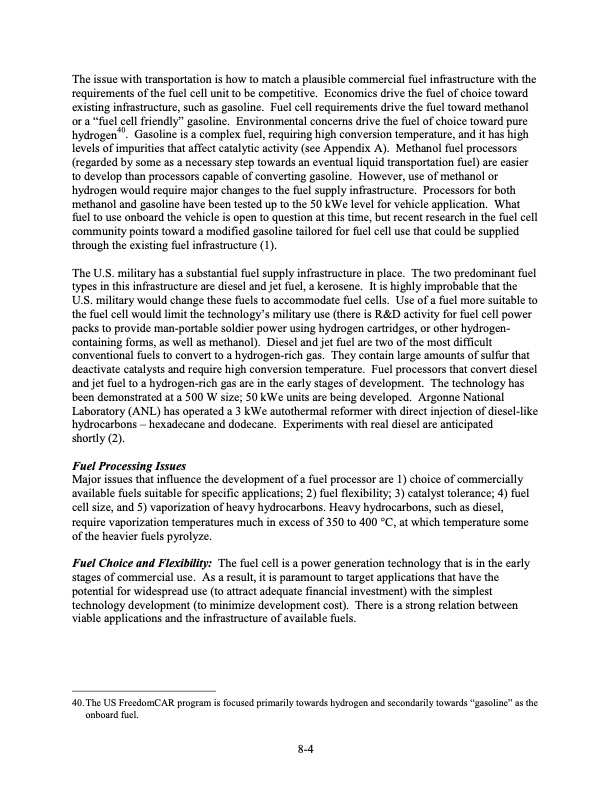
PDF Publication Title:
Text from PDF Page: 249
The issue with transportation is how to match a plausible commercial fuel infrastructure with the requirements of the fuel cell unit to be competitive. Economics drive the fuel of choice toward existing infrastructure, such as gasoline. Fuel cell requirements drive the fuel toward methanol or a “fuel cell friendly” gasoline. Environmental concerns drive the fuel of choice toward pure hydrogen40. Gasoline is a complex fuel, requiring high conversion temperature, and it has high levels of impurities that affect catalytic activity (see Appendix A). Methanol fuel processors (regarded by some as a necessary step towards an eventual liquid transportation fuel) are easier to develop than processors capable of converting gasoline. However, use of methanol or hydrogen would require major changes to the fuel supply infrastructure. Processors for both methanol and gasoline have been tested up to the 50 kWe level for vehicle application. What fuel to use onboard the vehicle is open to question at this time, but recent research in the fuel cell community points toward a modified gasoline tailored for fuel cell use that could be supplied through the existing fuel infrastructure (1). The U.S. military has a substantial fuel supply infrastructure in place. The two predominant fuel types in this infrastructure are diesel and jet fuel, a kerosene. It is highly improbable that the U.S. military would change these fuels to accommodate fuel cells. Use of a fuel more suitable to the fuel cell would limit the technology’s military use (there is R&D activity for fuel cell power packs to provide man-portable soldier power using hydrogen cartridges, or other hydrogen- containing forms, as well as methanol). Diesel and jet fuel are two of the most difficult conventional fuels to convert to a hydrogen-rich gas. They contain large amounts of sulfur that deactivate catalysts and require high conversion temperature. Fuel processors that convert diesel and jet fuel to a hydrogen-rich gas are in the early stages of development. The technology has been demonstrated at a 500 W size; 50 kWe units are being developed. Argonne National Laboratory (ANL) has operated a 3 kWe autothermal reformer with direct injection of diesel-like hydrocarbons – hexadecane and dodecane. Experiments with real diesel are anticipated shortly (2). Fuel Processing Issues Major issues that influence the development of a fuel processor are 1) choice of commercially available fuels suitable for specific applications; 2) fuel flexibility; 3) catalyst tolerance; 4) fuel cell size, and 5) vaporization of heavy hydrocarbons. Heavy hydrocarbons, such as diesel, require vaporization temperatures much in excess of 350 to 400 °C, at which temperature some of the heavier fuels pyrolyze. Fuel Choice and Flexibility: The fuel cell is a power generation technology that is in the early stages of commercial use. As a result, it is paramount to target applications that have the potential for widespread use (to attract adequate financial investment) with the simplest technology development (to minimize development cost). There is a strong relation between viable applications and the infrastructure of available fuels. 40.The US FreedomCAR program is focused primarily towards hydrogen and secondarily towards “gasoline” as the onboard fuel. 8-4PDF Image | Fuel Cell Handbook (Seventh Edition)

PDF Search Title:
Fuel Cell Handbook (Seventh Edition)Original File Name Searched:
fuel-cell-handbook.pdfDIY PDF Search: Google It | Yahoo | Bing
NFT (Non Fungible Token): Buy our tech, design, development or system NFT and become part of our tech NFT network... More Info
IT XR Project Redstone NFT Available for Sale: NFT for high tech turbine design with one part 3D printed counter-rotating energy turbine. Be part of the future with this NFT. Can be bought and sold but only one design NFT exists. Royalties go to the developer (Infinity) to keep enhancing design and applications... More Info
Infinity Turbine IT XR Project Redstone Design: NFT for sale... NFT for high tech turbine design with one part 3D printed counter-rotating energy turbine. Includes all rights to this turbine design, including license for Fluid Handling Block I and II for the turbine assembly and housing. The NFT includes the blueprints (cad/cam), revenue streams, and all future development of the IT XR Project Redstone... More Info
Infinity Turbine ROT Radial Outflow Turbine 24 Design and Worldwide Rights: NFT for sale... NFT for the ROT 24 energy turbine. Be part of the future with this NFT. This design can be bought and sold but only one design NFT exists. You may manufacture the unit, or get the revenues from its sale from Infinity Turbine. Royalties go to the developer (Infinity) to keep enhancing design and applications... More Info
Infinity Supercritical CO2 10 Liter Extractor Design and Worldwide Rights: The Infinity Supercritical 10L CO2 extractor is for botanical oil extraction, which is rich in terpenes and can produce shelf ready full spectrum oil. With over 5 years of development, this industry leader mature extractor machine has been sold since 2015 and is part of many profitable businesses. The process can also be used for electrowinning, e-waste recycling, and lithium battery recycling, gold mining electronic wastes, precious metals. CO2 can also be used in a reverse fuel cell with nafion to make a gas-to-liquids fuel, such as methanol, ethanol and butanol or ethylene. Supercritical CO2 has also been used for treating nafion to make it more effective catalyst. This NFT is for the purchase of worldwide rights which includes the design. More Info
NFT (Non Fungible Token): Buy our tech, design, development or system NFT and become part of our tech NFT network... More Info
Infinity Turbine Products: Special for this month, any plans are $10,000 for complete Cad/Cam blueprints. License is for one build. Try before you buy a production license. May pay by Bitcoin or other Crypto. Products Page... More Info
| CONTACT TEL: 608-238-6001 Email: greg@infinityturbine.com | RSS | AMP |